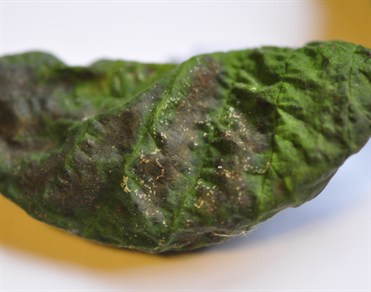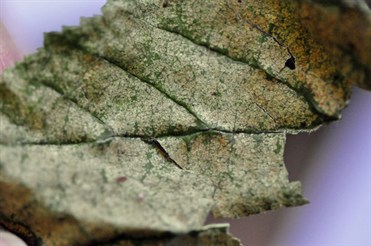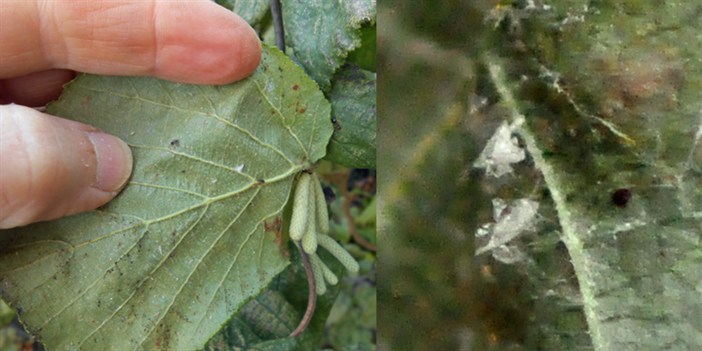Lace bug on filbert:
When Harry has a lacy problem
Noticing this pest
Controlling the insects
Applying this to other lace bugs
The leaves of this Harry Lauder's walking stick (Corylus
avellana 'Contorta') are being sucked dry by insects called
alder lace bug (Corythucha pergandei).
Below: The shrub's foliage
is discolored. Some leaves are stippled -- marked with many tiny
spots that are not chewed but sucked dry so the leaf seems dusty
and dry. On other leaves, larger sections have browned out or gone
white. These discolored areas are thin and crumbly.



Below: Looking even closer on the undersides of discolored
leaves, we see exoskeletons shed by growing insects and dark spots
of insect frass -- excrement.

Controlling lace bugs
In winter while the plant is leafless, lacebugs are pretty much
untouchable. Then they are well protected from contact killers
because they're in bark crevices or leaf litter. They're immune to
other poisons since they are not eating.
So, in the spring after you see such damage, wait a few weeks
after this shrub's budbreak, until redbuds bloom. Then. look at
some leaf undersides for signs of the lace bugs' return. If we see
them or their damage, apply an insecticide. Be sure to coat the
underside of the the foliage.
Almost any insecticide including soap will kill lace bugs when
they are just out of the egg in early spring.
In spring you may see the tiny dark eggs partially inserted into
the leaf underside. If so, wait one week and then check again
before applying an insecticide, since most insecticides can't kill
insects still in the egg. Alternatively, apply a horticultural oil
which if applied shortly before the hatch will coat and smother the
emerging insect.
In any event, re-check monthly, because lace bugs have several
generations each year. Spring survivors can multiply
prodigiously.
Other lace bugs, same
handling
There are many lace bug species, each peculiar to one or a group
of plants. The various lacebugs cause their hosts similar damage
and are handled the same way.
- Sycamore (Platanus) has sycamore lacebug, which can also host
on ash, hickory and mulberry
- Cherry has its own lacebug
- Azaleas and rhododendrons are host to azalea lacebug
- Alder can share its lacebug with elm, birch and hazel
- Hawthorn and quince can share a lacebug
- Walnuts, butternuts and lindens have walnut lacebug in
common
- Aster lacebug gets around to many daisy/aster relatives
- Poplar lacebug can live on poplar, willow, mountain ash, beech
and maple
More about lace bugs
http://ento.psu.edu/extension/factsheets/lace-bug
"…Nymphs are spiny and (dark)… …can be found clustered among
their dark feces and cast nymphal skins on lower leaf surfaces.
…The black eggs are elongate and placed on end in small groups on
the underside of leaves."
http://www.ipm.ucdavis.edu/PMG/PESTNOTES/pn7428.html
"Tolerate lace bug damage where possible; in most cases, it does
not seriously harm plants. Provide proper cultural care so plants
are vigorous. …Natural enemies of lace bugs include assassin bugs,
lacewing larvae, lady beetles, jumping spiders, pirate bugs, and
predaceous mites. These predators may not appear in sufficient
numbers until after lace bugs become abundant; their preservation,
however, is an essential part of a long-term integrated pest
management program."